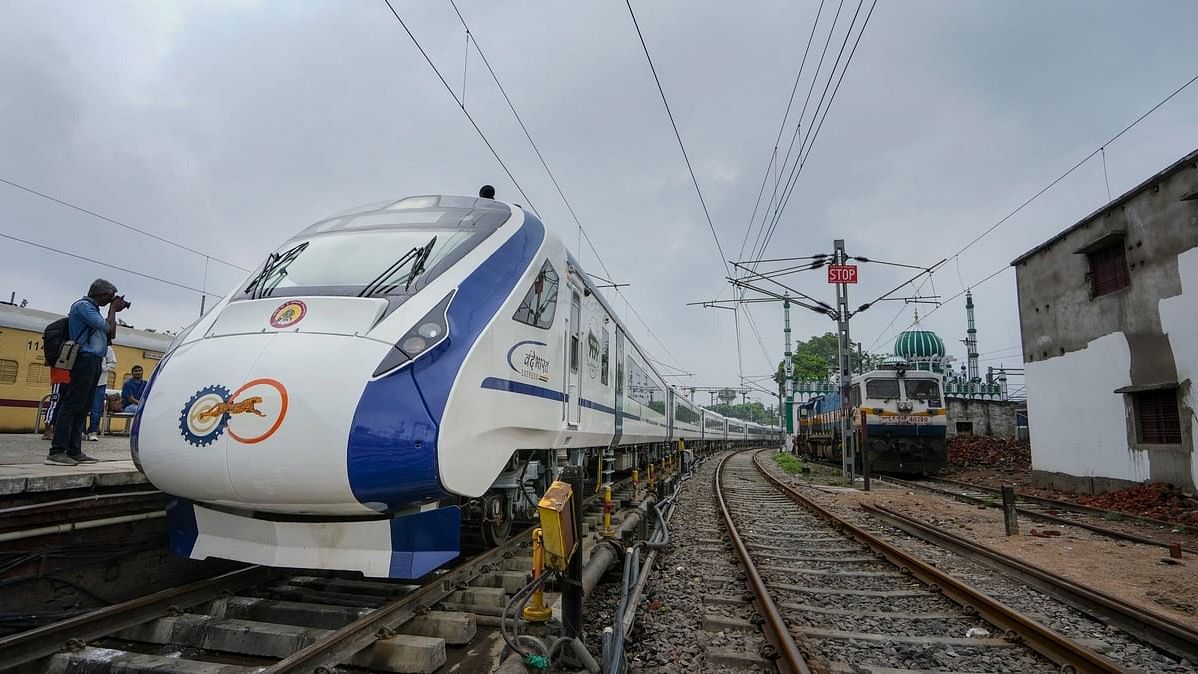
A Vande Bharat train.
Credit: PTI Photo
New Delhi: The average speed of Vande Bharat trains has decreased from 84.48 kmph in 2020-21 to 76.25 kmph in 2023-24, the railway ministry said in a response to an RTI query.
Railway officials said not only Vande Bharats but many other trains are also maintaining cautionary speed at places were 'huge infrastructural work' is underway.
"Besides this, some Vande Bharat trains have been launched in difficult terrain areas where there are speed restrictions due to geographical reasons or extreme weather conditions," a railway official said.
Citing the example of the Vande Bharat train between Mumbai CSMT and Madgaon, an official of the Central Railway Zone said, "Most of the Konkan railway area is 'ghat' section where trains pass through low height mountain ranges. It is a difficult terrain area where increasing speed could compromise safety. Things become very challenging during the monsoon season when we have to keep the maximum speed for all trains at 75 kmph."
The RTI applicant, Madhya Pradesh-based Chandra Shekhar Gaur, said, "The data, obtained through the RTI, shows that the average speed of Vande Bharat trains was 84.48 in 2020-21, which decreased to 81.38 kmph in 2022-23. It further deteriorated in 2023-24 to 76.25."
Launched on February 15, 2019, the Vande Bharat is a semi-high speed train which can run at a maximum speed of 160 kmph. However, it cannot go beyond 130 kmph anywhere in the country, except on the Delhi-Agra route, due to unsuitable track conditions.
"There are certain segments of tracks between Delhi and Agra which were developed in 2016 for India's first semi-high speed train Gatiman Express to run at 160 kmph. Only on those segments, the Vande Bharat also runs at 160 kmph speed. Rest of the places, its maximum speed is either 130 or less than," another railway official said.
He said the railways has been upgrading tracks to meet the speed requirement of the Vande Bharat and "it is because of these reasons there are cautions at various places". "Once these upgrades are over, we will have trains which will go up to 250 kmph," the official said.
Some of the routes on which the Vande Bharat's speed is worse than its overall average speed are Dehradun-Anand Vihar (63.42 kmph), Patna-Ranchi (62.9 kmph) and Coimbatore-Bangalore Cantt (58.11 kmph).
An expert engaged in track construction said the first Vande Bharat was launched in February 2019 and it has been more than five years since then, but the railways is yet to replace tracks on any route so that the train can run at its maximum operating speed of 160 kmph.
"The railways' argument is that since infrastructure work is going on, it restricts the speed of Vande Bharat trains. But this is also true that in five years, it has failed to lay tracks suitable for running semi-high speed trains," the expert said requesting anonymity.
However, the railway ministry maintains that Vande Bharat trains are very popular and till March 31, more than 2.15 crore people have travelled by it.
The Vande Bharat lists a number of features such as Kavach protection, faster acceleration and semi-high speed operation up to 160 kmph, fully sealed gangway for free passenger movement, automatic plug doors, reclining ergonomic seats and comfortable seating with revolving seats in executive class, better ride comfort among others.
"A total of 284 districts across the country have been connected to the Vande Bharat Express and This number will continue to increase in the future. A total of 102 Vande Bharat trains are providing services on 100 routes of the railway network," a railway official said.